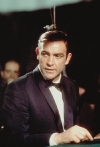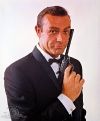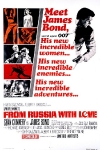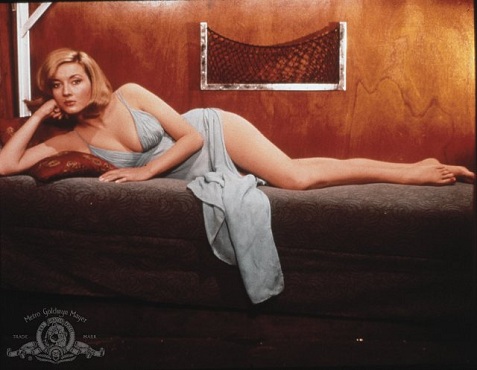Critics and filmmakers may prefer “From Russia With Love” and “Goldfinger,” and many complain about those long underwater sequences but, to a lot of fans, Bond #4 remains the ultimate in spy action, intrigue, gadgets, and girls, girls, girls. It also remains the all-time box office record holder of all the Bonds. It’s also only the second, and so far final, Bond film to ever win an Oscar — for special effects of course.
“Thunderball” (1965)
The Plot
Unperturbed by the 007-related deaths of Dr. No, Red Grant, Rosa Klebb, and countless other operatives, the amalgamated baddies of SPECTRE return with their most diabolical plot yet. The plan this time is nuclear blackmail, as SPECTRE Operative # 2 takes possession of two hydrogen bombs and informs England and the U.S. that they’ll either part with £100 million or kiss one or two of their favorite cities goodbye. Without any viable strategy other than complete capitulation, the only respectable option for the free world seems to be sending Bond to kill, copulate, and skin-dive his way to victory over nuclear terrorism.
The Backstory
With the series chugging along at the rate of roughly one movie a year and a worldwide spy craze underway, an observer might well have expected that the James Bond phenomenon had peaked with the blockbuster success of “Goldfinger.” Then again, a lot of people in 1965 were also figuring that those flash in the pan teen idols, the Beatles, had peaked with “I Wanna Hold Your Hand.”
The EON Production team led by producers Albert R. “Cubby” Broccoli and Harry Saltzman knew that their hot streak was still very much in play. They cannily chose to triple-down with a budget roughly three times higher than the already relatively high ($3 million!) “Goldfinger” budget and all-out marketing and cross-promotional blitz. As luck and skill would have it, the most eagerly anticipated Bond film would ultimately top the box-office success of “Goldfinger” by $20 million with a worldwide take of $141.2 million — not quite enough cash to satisfy a Bond villain, but getting there.
The amazing part is that the film was ever made at all, as the project had been plagued by legal difficulties for years. “Thunderball” began life as a screenplay that James Bond creator Ian Fleming developed with, among others, screenwriter Jack Whittingham and producer Kevin McClory. Fleming eventually tired of the complexities of getting a Bond movie on the screen and abandoned the project. He nevertheless used a great deal of the abortive script’s story in his 1961 novel of “Thunderball.”
Things got complicated when producers Albert R. “Cubby” Broccoli and Harry Saltzman entered the mix. Broccoli and Saltman’s EON team originally initially saw “Thunderball” as the best kick-off for the Bond series, even if its action would have to be scaled back considerably to fit their budget. A lawsuit brought by Kevin McClory nixed the idea, even though writer Richard Maibum had already completed a screenplay.
The suit was eventually settled out of court by an ailing Ian Fleming. With Fleming having passed on and an obvious cash cow of enormous magnitude before him, victorious rights holder McClory agreed to an EON-produced film of “Thunderball” on certain conditions, including that he be the sole credited producer.
With McClory on board, it was time to reassemble the Bond team. Though flush with success, “Goldfinger” director Guy Hamilton pleaded exhaustion. In his stead, original Bond director Terrence Young was induced to return for one final outing, while such key personnel as editor Peter Hunt, director of photography Ted Moore, production designer Ken Adam, stunt man/action choreographer Bob Simmons, and composer John Barry all happily returned. As per the writing MO on the early Bond films, the work of American screenwriter Richard Maibum was given a more English make-over by a Brit, TV scribe John Hopkins. To handle the considerable challenge of filming underwater, EON turned to nature film specialists Ivan Tors Productions, who had achieved great success filming aquatic material for television with their hit shows,”Sea Hunt” and “Flipper.”
As for the stars, while the pressures of true superstardom were starting to weigh on Sean Connery, he was still on board and not yet ready to kill the golden but increasingly painful goose that was Bondage. For his leading lady, EON passed on three actresses soon to become superstars — Raquel Welch, Julie Christie, and Faye Dunaway — before settling on their final choice. More about that below.
The Bond Girls (Rule of 3 + 2)
Bond keeps up his sexual batting average with his usual three trips to home plate in “Thunderball.” Oddly enough, while more than maintaining his rascally ways when it comes to women, he manages what appear to be purely professional relations with two of the film’s five “Bond girls.”
Madame LaPorte (Mitsuoaka): The part was uncredited, and we never find out much about the French operative who assists Bond’s revenge mission against Jacques Bouvar in the opening sequence. Even so, the subtly exotic Madame LaPorte definitely lends an air of intrigue to the opening adventure. The French-Eurasian actress, Mitsuoaka, born Maryse Guy, was a former stripper who seems to have spent a lot of the sixties riding the spy wave around Europe, having already appeared in such early sixties capers as “License to Kill” and “Agente 077 Missione Bloody Mary.” She passed on in 1995.
Paula Caplan (Martine Beswick): Bond’s gorgeous “island girl” assistant appears to be an entirely competent MI6 operative. Even though we’ve barely seen them even flirt, Bond is clearly upset when she meets an unpleasant but honorable end under the custody of SPECTRE — though not so upset that he can’t handily boff an attractive enemy operative. Very much a cult star in her own right, this marks either the second or third and final Bond-girl appearance for actress Martine Beswick. She had also played one of the feisty-but-affectionate Gypsy women in “From Russia with Love” and might have appeared as one the dancing silhouetttes in the “Dr. No” credit sequence.

You can follow us on Twitter and Facebook for content updates. Also, sign up for our email list for weekly updates and check us out on Google+ as well.
Posted in: Movies
Tags: 007, 007 50th anniversary, 007 films, 007 gadgets, 007 movies, 007 One by One, Adolfo Celi, Albert R. "Cubby" Broccoli, Anthony Dawson, beautiful Bond women, best Bond movie moments, Bond babes, Bond films, Bond gadgets, Bond girls, Bond movies, Bond one by one, Château d'Anet, classic Bond gadgets, Claudine Auger, Desmond Llewelyn, Domino Thunderball, Dominque "Domino" Derval, Emilio Largo, Eric Pohlman, Ernst Stavro Blofeld, Felix Leiter, Fiona Volpe, Harry Saltzman, Ian Fleming, iconic James Bond moments, Jack Whittingham, James Bond, James Bond 007, James Bond 50th anniversary, James Bond actresses, James Bond babes, James Bond blog, James Bond craze, James Bond franchise, James Bond girls, James Bond hookups, James Bond movies, James Bond music, James Bond romantic endings, James Bond violence, jet pack, John Barry, Kevin McClory, license to kill, Lois Maxwell, Luciana Paluzzi, Madame LaPorte, Martine Beswick, Maurice Binder, memorable Bond scenes, Mitsuoaka, Molly Peters, Moneypenny, Patricia Fearing, Paula Caplan, Rik van Nutter, SPECTRE, Thunderball
































